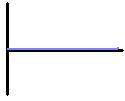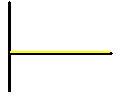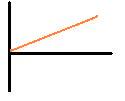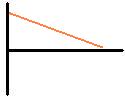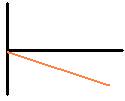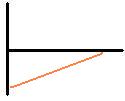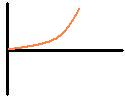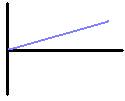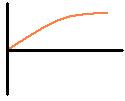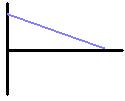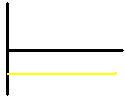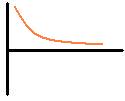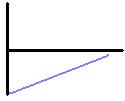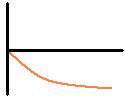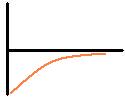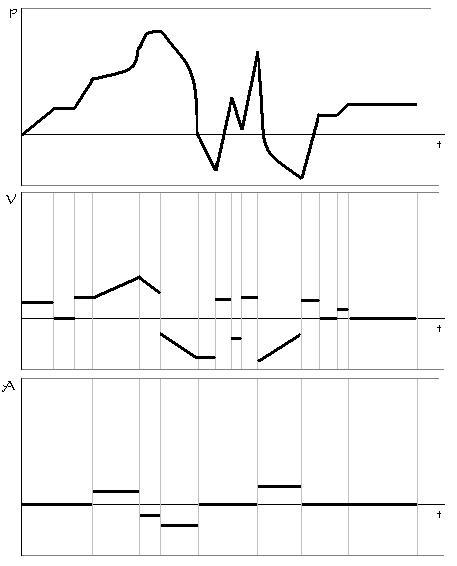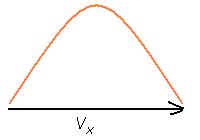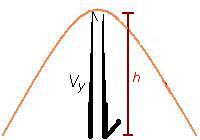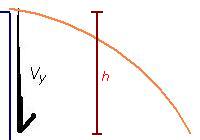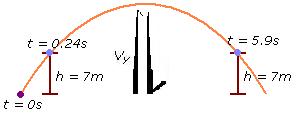| Part I: Concepts | Kinematics is the study of motion. Sa motion, several concepts ay ginagamit. |
| Scalar vs vector | Again, we go back to the very first lesson concerning scalar and vector quantities. The difference between the two is with the quantity they define. Ang pinaka-common na ginagamit na quantities in kinematics ay ang displacement, velocity at acceleration. Remember na velocity and displacement ay vector counterparts ng distance at speed. Vectors have direction, in addition to magnitude. Scalars have only magnitude. Sometimes, negative vectors do not necessarily mean negative magnitudes, pde rin going to the negative direction kaya nagka ganun. |
| Frame of reference | Frame of reference = the space in which an object is moving, na nakikita ng taong nakakakita. For example, may tao sa loob ng bus na naglalakad papuntang back of the bus habang bus ay nagm-move forward. From sum1 inside, ang tao ay makikita niyang going towards him (negative direction). Pero from sum1 outside, ang tao ay nagm-move forward kac d whole bus is moving forward. |
| Part II: Uniform Motion | This topic shows objects travelling at a constant speed. They experience zero acceleration, and the speed is the same all throughout the entire path. Preferred units ay m/s, km/h, mi/h | |||||||||||||||
| Formulas (formulae?) | Pinakaimportanteng formula dito ay speed = dist ÷ time. From this, pwdeng iderive ang dist. d = st And also time. t = d ÷ s |
|||||||||||||||
| Problem Solving / Application | Compute the average speed of a formula one car in one race. On the average, ang isang race ay nagt-take ng 70 laps. In one lap, on the average, may mga 4.5km to complete a circuit. And on the average, a race lasts for about one hour and 45 minutes. Using these facts, maso-solve natin ang average speed ng mga f1 cars sa race.
|
|||||||||||||||
| Part II: Uniform Accelerated Motion | Shows objects travelling at constant acceleration. Their speed increases by the same amount every second. The unit of measure is any distance over the square of any time. Preferred unit ay m/s2 | ||||||||||||
| Formulas/e | velocity = acceleration x time <--starting from rest vf = vo + at <--in motion dist. = Vot + ˝at2 <--if starts from rest, then Vo = 0 and ur left w/ d = ˝at2 d = Vf2 - Vo2 2a |
||||||||||||
| Problem Solving/Application | The main difference bet velocity and acceleration is dis: ang speed refers to how fast an object
moves. gano kabilis siya nagch-change in position. While ang acceleration, refers 2 how fast
an object changes speed, at what rate ba yun bumibilis or bumabagal. Using our previous problem sa formula 1, suppose nasa ibang circumstances, kung ang car ay nag- aaccelerate starting from rest and maintains a value of 6m/s2 until it reaches d average speed, gano katagal kaya ito naga-accelerate?
|
||||||||||||
| Part II˝: Freefall | Special case of uniform accelerated motion. In freefall, an object is in motion without any xternal force acting upon it other than gravity. Always starts from rest, kac wla ngang initial force that acted on it. | ||||||||||||
| Concepts/ Formulae (i prefer e) | Since the body is falling, we need to consider an object's acceleration due to gravity. Eto ay ang
constant na -9.8m/s2 which replaces a in our UAM equations. This makes it easy kac one of
the variables alam mo na. The formulae for speed and distance fallen are as follows: v = gt <--where g = -9.8m/s2 d = ˝ gt2 <--dito lam na natin ang g natin as opposed to normal UAM, value ng a varies Bakit negative lagi ung g? It's because of the effect of acceleration. If it moves to the positive direction (opposing gravity - UP) then the object is slowing down kaya naging negative. Pag speeding up naman (with gravity - DOWN) edi negative parin since it's going towards a negative direction. This comes in handy pagsolve ng equations minsan nagkakagulo dahil sa sign ng g. Hassle tlga ang g... |
||||||||||||
| Problem solving/Application | A stone was dropped from the top of a cliff. If the speed at impact with the ground is 33m/s, how
much time did it take to reach the ground and how high is the cliff?
|
||||||||||||
| Conclusion (for part II and II˝) | in uniform accelerated motion, velocity varies directly as time, and acceleration is the constant
of variation. v = at2 means na pag mas mahaba ung time, pag mayroong acceleration,
mas malaki ung final velocity. Sa freefall a is replaced with the constant g, which is equal to
-9.8m/s2 distance naman varies directly as the square of time, with half of the acceleration as the constant of variation. if given an initial velocity before starting to accelerate, edi just get the speed change by mult. d acceleration by time. then add dun sa initial velocity na given. Freefall ay special case of UAM. laging zero ang initial velocity meaning it starts from rest. at ang acceleration ay laging constant (-9.8m/s2) kac eto ang acceleration ng falling body. |
||||||||||||
| Part III: Motion Graphs | Madugong topic ito. Since this is a reviewer, dapat alam nyo na how to make rough kinematic graphs of the motion of the object, concerning the position, velocity and acceleration of the object. | ||||||||||||||||||||||||||||||||||||||||||||||||||||||||||||
| How to graph correctly/effectively | First thing to draw is the coordinate plane/matrix thingy. Magdraw ng L shape. In some cases, tho,
ull have to extend the vertical line downwards. This gives room for negative values. The time is plotted on the x-axis (independent) and the y-axis can stand for displacement, velocity, or acceleration. Displacement-time graphs: This usually starts from the origin (where the lines meet). As the object moves, note of the direction its going, kc vector quantity ang displacement. North, up, east and right give positive displacements. Draw above the x-axis (time line). South, down, west and left give negative displacements. Draw below the time line. Next, note the movement relative to the origin. It can be towards or away from it. If away from origin, move farther upward or farther downward from the time line. If towards origin, move from a point away from time line towards the time line. An object at rest has a flat line. An object moving at uniform motion has a diagonal line. An object moving at uniform accelerated motion has a curved line. Tandaan!: time is always passing, so you have to move to the right lagi. Can never move to the left This also explains bakt ang x-axis puro nasa right lang. No such thing as negative time. Slope of the graph gives the value for the velocity. Changing slope means diagonal line for the velocity. Increasing steepness = increasing vel. Velocity-time graphs: Sometimes this has a value at the beginning of time so it doesn't always start sa origin. A zero value means the object is at rest A flat line not at zero means the object is moving at constant velocity. A diagonal line means the object is accelerating - there is a change in velocity. Wlang curved line sa v-t graph. At least, wla dito sa zobel/highschool. A negative velocity means a negative direction, not a negative magnitude. Slope of the line becomes the value for acceleration. If constant velocity, zero accel. Area between the line and origin becomes the position/displacement. Acceleration-time graphs: Wlang slanted lines dito, since wlang curved lines sa v-t graph. Lahat flat lines. At zero can either mean at rest or moving at constant speed. Only pag may change in velocity magkakaroon ng value. And it's always a flat line (highskul) Negative acceleration can mean a positive magnitude but a negative direction or.. A negative magnitude. Pag negative magnitude it means object is slowing down. Area bet. the line and the origin becomes the value for velocity. |
||||||||||||||||||||||||||||||||||||||||||||||||||||||||||||
| Examples of graphs |
|
||||||||||||||||||||||||||||||||||||||||||||||||||||||||||||
| Motion story | The complex version of the graphs. Dito ic-combine several cases of the graph. Gagamitin ko nalang
para dito ang project namin ni ryan sa science.
|
||||||||||||||||||||||||||||||||||||||||||||||||||||||||||||
| Part IV: Projectile Motion | Coming soon! just in case di umabot, pls study!!! | ||||||||||||||||||||||||||||||||||||||||||||||||||||||||||||||||||||||||||||||||
| The concept | Motion of an object projected in a gravitational field. The object thrown, called the projectile,
then follows a curved path (called its trajectory). The paths of these projectiles vary on
what initial velocity it was projected with, the angle of inclination, and the object's height from
the ground. We will apply many of the lessons that were tackled this year sa physics, these include
resolving vector quantities to x and y components as well as the lessons in UM and UAM. Actually projectiles ay combination ng UM and freefall. There are just special cases involved w/c add a few extra steps to the problem solving |
||||||||||||||||||||||||||||||||||||||||||||||||||||||||||||||||||||||||||||||||
| Formulae |
|
||||||||||||||||||||||||||||||||||||||||||||||||||||||||||||||||||||||||||||||||
| Problem solving | Instead of the normal ako gagawa lahat tas nakadrawing lang, ssbihin ko nalang ung formula dat u
need to use, with some hints.
|
||||||||||||||||||||||||||||||||||||||||||||||||||||||||||||||||||||||||||||||||
| Rules to remember: | There is no x velocity if the launch angle is 90°. There is no y velocity if the launch angle is 0°. If there is no y velocity there is no flight; wlang mgyyare if 0° ung angle, kahit gano kalakas i- launch. Increasing the launch angle increases the time of flight; max time if 90° ang launch θ. The projectile has maximum range at θ = 45°. Also, the x and y velocities are equal. Any launch angle below or above 45° will give a shorter range. Complimentary angles (add up to 90°) have equal ranges but different times of flight. The perfect curve (equal height and range) occurs at θ = 76°. Changing the Vx will not affect time of flight Changing the Vy affects the time of flight and subsequently, the range. |
||||||||||||||||||||||||||||||||||||||||||||||||||||||||||||||||||||||||||||||||
| Harder problems | Dito titignan ang quadratic formula, pati na rin ung pagc-combine ng mga equations in one.
|
||||||||||||||||||||||||||||||||||||||||||||||||||||||||||||||||||||||||||||||||

